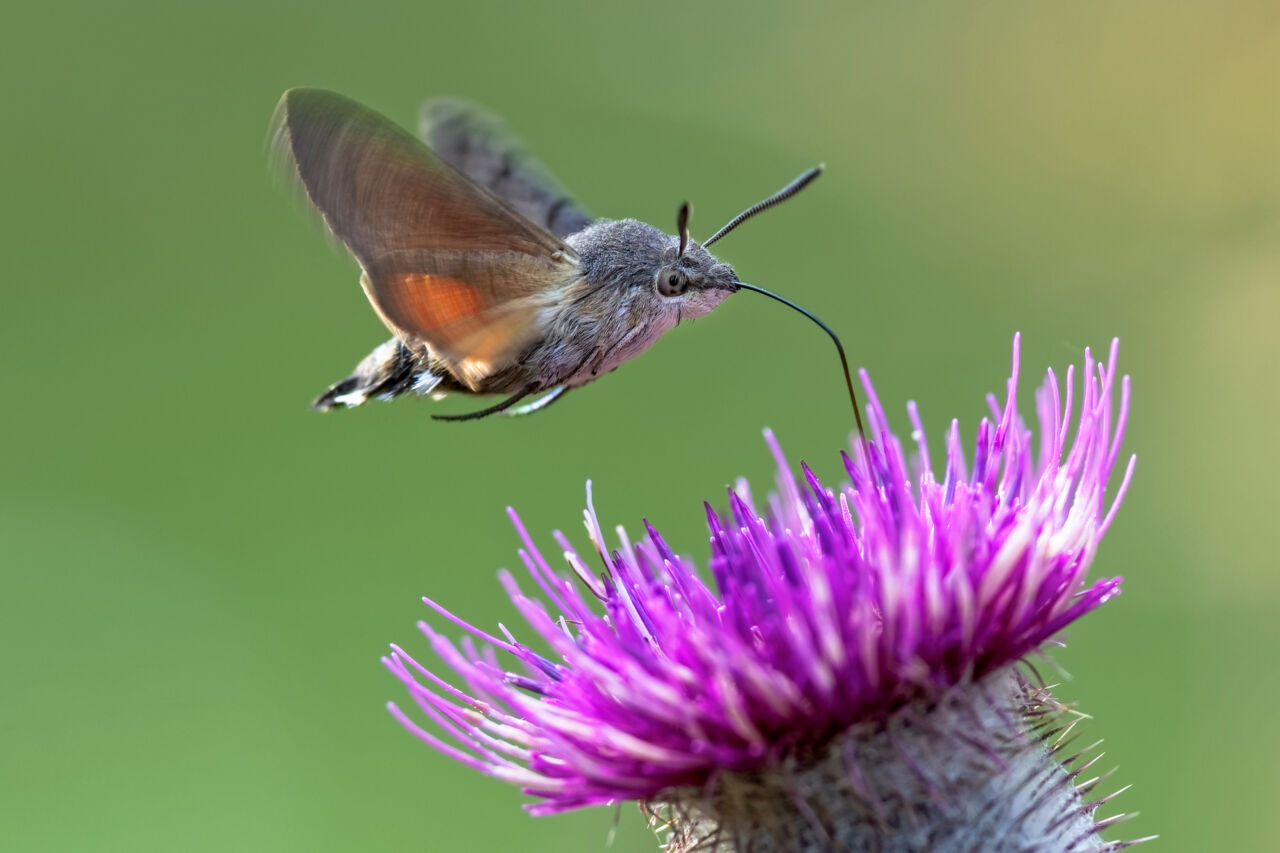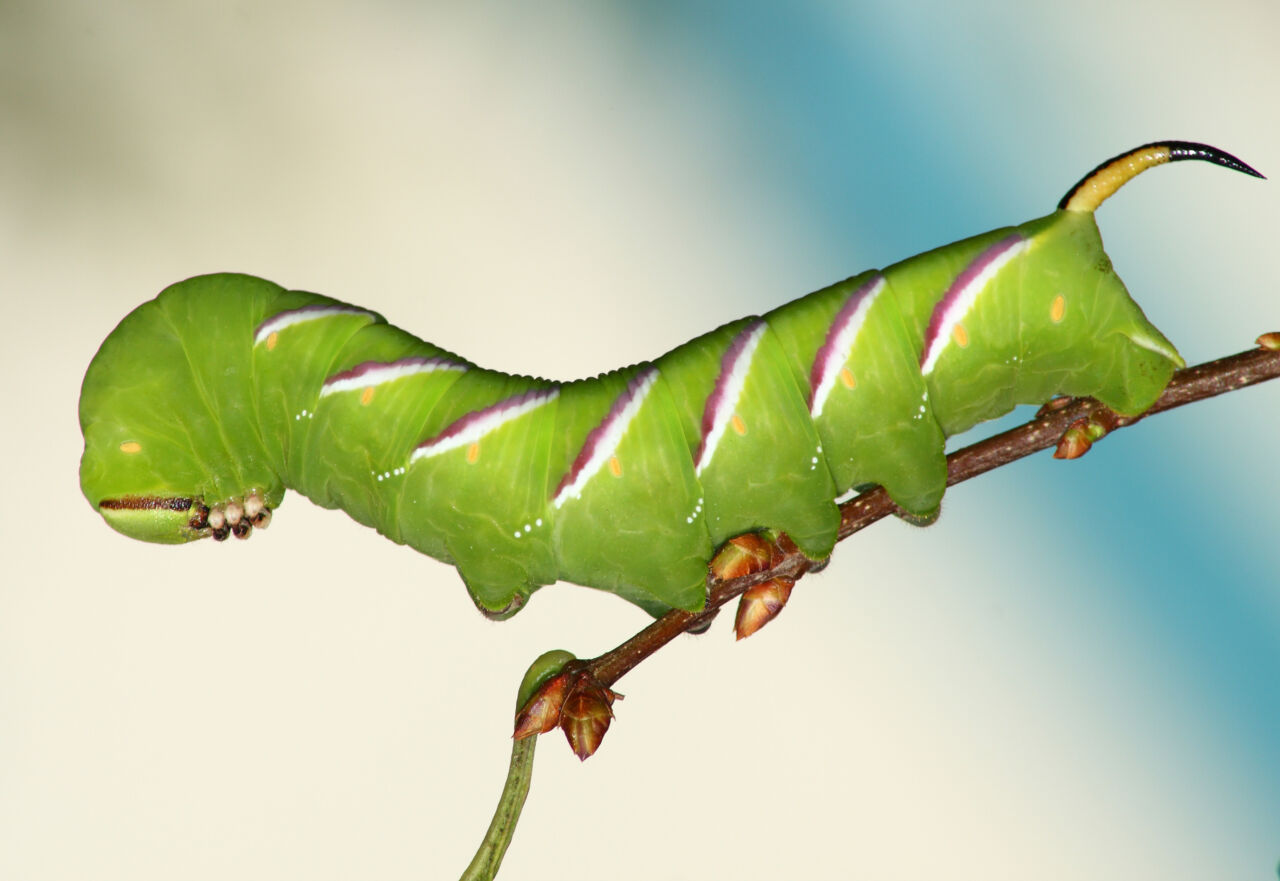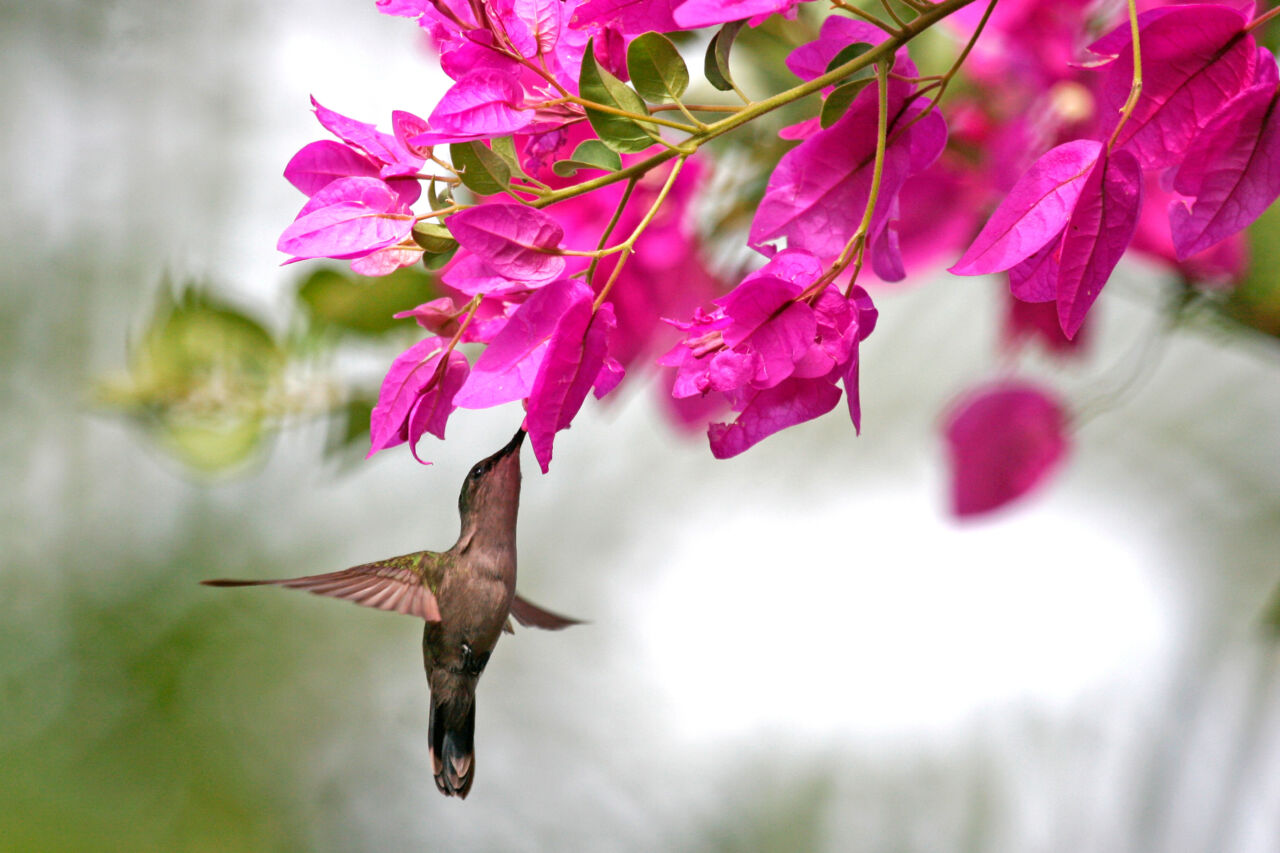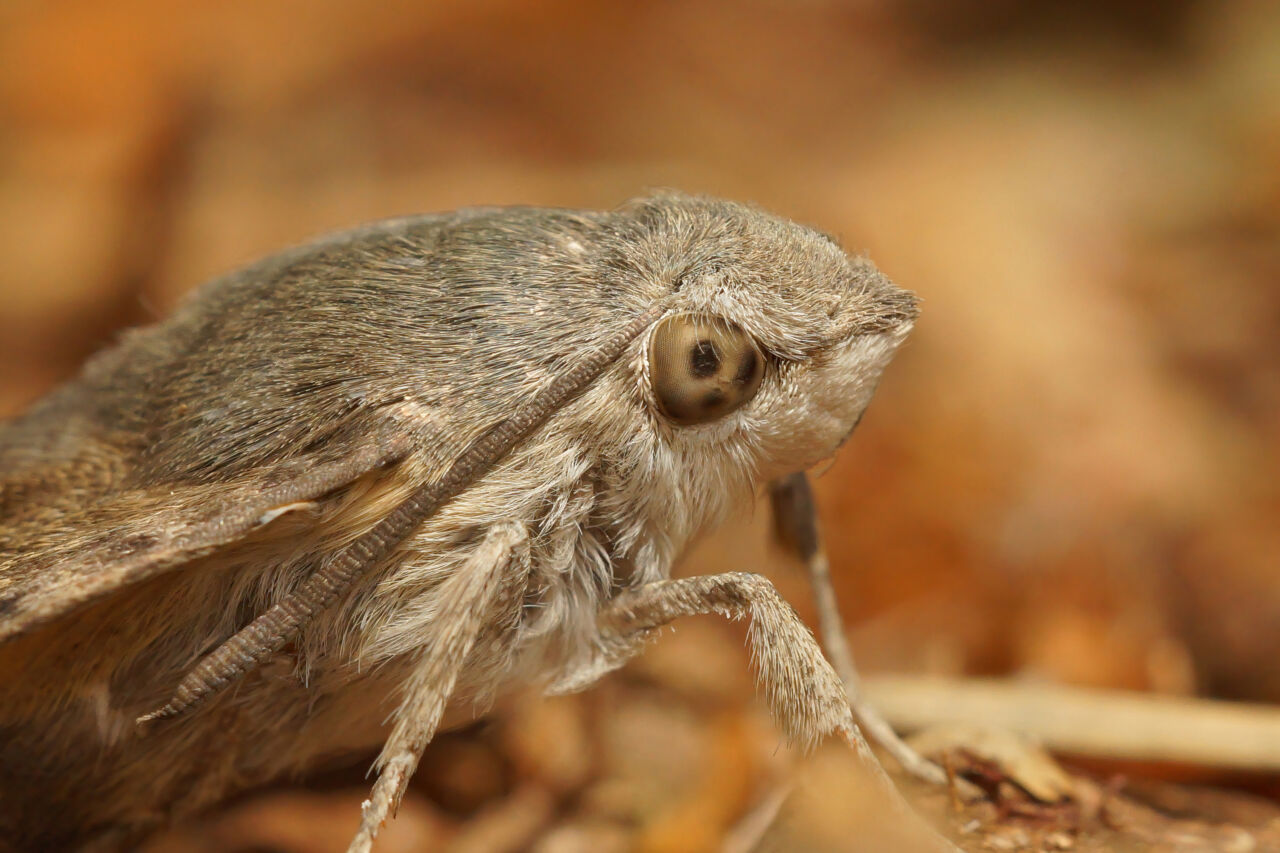Not a hummingbird – The hummingbird hawkmoth
Wait, was this a hummingbird? If you are in Switzerland pondering about an unidentified flying object hovering over the flowers, then no, it was not a hummingbird, since they live only in the Americas. It was most probably a hummingbird hawkmoth.

The hummingbird hawkmoth might be mistaken for a hummingbird. Image: Adobe Stock
Profile
- The hummingbird hawkmoth Macroglossum stellatarum belongs to the family of Sphingidae (Sphinx moths).
- Sphinx moths are named after the Great Sphinx of Giza, and when their caterpillars are at rest, they raise their front legs and head, resembling the iconic Egyptian statue
- Hawkmoths pollinate flowers while feeding on nectar with their long proboscis.
- The hummingbird hawkmoth does not land on flowers but stays seemingly still in the air in front of the flower flapping its wings at 85 beats per second, 35 wingbeats faster than a hummingbird.
- Hummingbird hawkmoths are not considered endangered.
Classification
- Kingdom
- Animalia
- Phylum
- Arthropoda
- Class
- Insecta
- Order
- Lepidoptera
- Family
- Sphingidae
- Genus
- Macroglossum
- Species
- M. stellatarum

This pose has given Sphinx moths their name as it resembles the Egyptian Great Sphinx of Giza. The picture shows the caterpillar of Sphinx ligustri. Image: Modified from Adobe Stock
Similar but unrelated
Due to their similarity to hummingbirds, hummingbird hawkmoth sightings are often falsely reported as hummingbird sightings. Their similarity can be accredited to a process called “convergent evolution”. Convergent evolution happens if two organisms without a common ancestor end up alike in looks and/or behavior because they have adapted to a similar ecological niche. Hummingbird hawkmoths and hummingbirds not only look alike, but both feed on nectar, using their long proboscis (a tubular mouthpart comparable to a tongue) and tongue, respectively, while hovering mid-air in front of the flower.

Yeah, I'm the hummingbird… Image: Adobe Stock
Built-in drinking tube
The hummingbird hawkmoth has the longest proboscis amongst diurnal (active during the day) flower-visiting insects in Europe. It is 2.5 – 2.8 cm long but rolls up when not in use. Although it sounds like a huge tongue for an insect, the tongue of another species of hawkmoth, the Wallace’s sphinx moth (Xanthopan praedicta) found in Madagascar, can be up to 28.5 cm long.

The hummingbird hawkmoth can roll up its proboscis when it is not using it. Image: Adobe Stock
The hummingbird hawkmoth, and other moths of the moth family Sphingidae, play a critical role in the pollination of many plant species. Their long proboscis allows them to reach deep into the flowers to access nectar, unintentionally picking up pollen on their nectar coated proboscis, which they transfer to other flowers as they feed. The longer their proboscis the longer the nectar tube of the flower can be and thus a remarkable variety of hawkmoths and flowers with long nectar tubes have coevolved.
Did you know?
Xanthopan praedicta (Wallace’s sphinx moth) got its name because its existence was predicted by Alfred Russel Wallace and Charles Darwin in the years 1867 and 1862, respectively, when they examined specimens of a star orchid with a nectar tube 20-35 cm long. Such an insect must exist, they inferred, otherwise the flower would not be fertilized. In 1903 the predicted moth was found and described as a subspecies of the African sphinx moth (Xanthopan morganiiand). In 2021 it was recognized as a new species. Although the moth and the flower co-evolved, it is especially the orchid that relies entirely on the pollinating services of the moth. The moth can also drink nectar from other flowers with long flower nectar tubes and pollinates them in the process.
Here's looking at you, kid
Like most other insects, hawkmoths have a compound eye, made up of countless tiny units arranged in a hemisphere. On the surface of the eye, these units are visible as polygonal shapes, the facets. When you look at a hawkmoth you may get the impression that its eyes are following you wherever you go. However, the moving dark spot you see is not a pupil. It’s a patch of facets absorbing most of the light coming from your direction. This is called a pseudopupil and can also be observed e. g. in the eyes of a mantis.
Unlike other hawkmoths, the hummingbird hawkmoth is active during the day and thus has developed some features not seen in other moths. The front area of the eye has bigger facets and more light receptors, which gives the moth a sharp, bright and very detailed image of the world in proximity. This special eye structure allows M. stellatarum to focus on a flower's entrance while hovering and feeding.

The hummingbird hawkmoths eye looks as if it had a pupil. Image: Adobe Stock
Accomplished navigators
Hummingbird hawkmoths are mainly distributed in Southern Europe but during the summer they cover great distances in a couple of weeks and migrate in great numbers to Central and Northern Europe. How individual insects manage to travel such long distances was recently studied in a species of the same family, the death’s head hawkmoth (Acherontia atropos). A research team in Germany investigated the impressive migratory ability of this nocturnal hawkmoth by fitting individual moths with transmitters and following them in a light aircraft to record their movements by GPS. The moths were able to maintain their flight trajectories over long distances thanks to their adeptness at leveraging favorable winds by flying slow at higher altitudes, as well as their ability to handle unfavorable conditions by flying faster and closer to the ground. The researchers concluded that an internal compass helps the moths maintain their trajectories independent of wind conditions. While the exact details of their migration patterns are still being studied, hawkmoths are a remarkable example of small insects capable of traveling long distances.
References
Shultz D. 2021. New species has longest tongue of any insect. doi: 10.1126/science.acx9280. https://www.science.org/content/article/new-species-has-longest-tongue-any-insect Accessed June 2023
Pittaway AR. Sphingidae of the Western Palaearctic. http://tpittaway.tripod.com/sphinx/list.htm Accessed April 2023.
Warrant E et al. 1999. Physiological optics in the hummingbird hawkmoth: a compound eye without ommatidia. The Journal of Experimental Biology. 202: 497-511. https://doi.org/10.1242/jeb.202.5.497
Myles HM et al. 2022. Individual tracking reveals long-distance flight-path control in a nocturnally migrating moth. Science. 377: 764-768. https://doi.org/10.1126/science.abn1663
Kugler J. 2018. Förderung von Tagfalterpopulationen durch artgerechtes Habitat Management. Charakteristika und Elemente in Privatgärten Ostösterreichs, die Tagfalter und deren Raupen bevorzugen. Master Thesis
Richarz K & Kremer BP. 2019. Gliederfüsser – eine ganz geheimnisvolle Grossmacht. Geniale Tiere. Pp 49-152. http://dx.doi.org/10.1007/978-3-662-58643-3_2
